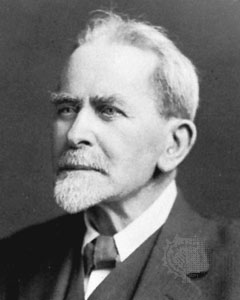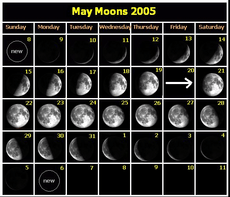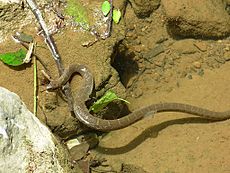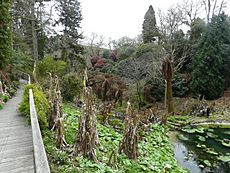James George Frazer facts for kids
Quick facts for kids
Sir James George Frazer
|
|
|---|---|

Sir James George Frazer in 1933
|
|
| Born | 1 January 1854 Glasgow, Scotland
|
| Died | 7 May 1941 (aged 87) Cambridge, England
|
| Alma mater | |
| Known for | Research in mythology and comparative religion |
| Awards | Order of Merit Fellow of the Royal Society |
| Scientific career | |
| Fields | Social anthropologist |
| Institutions | |
| Influences |
|
| Influenced |
|
Sir James George Frazer (1 January 1854 – 7 May 1941) was a Scottish expert who studied people and their cultures. He was also a folklorist, someone who studies traditional stories and customs. Frazer was very important in the early days of learning about mythology (the study of myths) and comparative religion (comparing different religions).
His most famous book, The Golden Bough (published in 1890), explored and described the many similarities among magical and religious beliefs from all over the world. Frazer suggested that human beliefs developed in three main stages: first came primitive magic, then religion, and finally, science.
Contents
About James Frazer's Life
James George Frazer was born on January 1, 1854, in Glasgow, Scotland. His father, Daniel F. Frazer, was a chemist.
Early Life and Education
Frazer went to school at Springfield Academy and Larchfield Academy in Helensburgh. He later studied at the University of Glasgow and Trinity College, Cambridge. At Cambridge, he earned top honors in classics, which means he was an expert in ancient Greek and Roman studies. He remained a Classics Fellow at Trinity College for his entire life. After college, he studied law but never worked as a lawyer.
Career and Recognition
Frazer was chosen four times to be a Fellow at Trinity College. He spent most of his life connected to the college, except for one year (1907–1908) when he taught at the University of Liverpool. In 1914, he was given the title of Sir (knighted) for his important work.
In 1921, a special series of public lectures about social anthropology was created in his honor. These lectures, called the Frazer Lectures, are held at the universities of Cambridge, Oxford, Glasgow, and Liverpool. From 1930 onwards, Sir James had severe vision problems.
Family and Later Years
In 1896, Frazer married Elizabeth Grove, who was a writer. Her family came from a region called Alsace. Elizabeth later turned parts of Frazer's Golden Bough into a book of children's stories called The Leaves from the Golden Bough.
Sir James and his wife, Lilly, both passed away in Cambridge, England, on May 7, 1941, just a few hours apart. They are buried together at the Ascension Parish Burial Ground in Cambridge.
Frazer's Studies on Myth and Religion
Sir James George Frazer became an expert in the study of myths and religion. He was very interested in how people's beliefs changed over time.
How Beliefs Evolved
Frazer believed that magic and science were similar in some ways because both involved trying out ideas and seeing what happened. He thought that magic was like an early form of science.
In contrast, Frazer described religion as believing in powerful, unseen forces and trying to please them. He suggested that human societies first relied on magic, then developed religions, and eventually moved towards scientific understanding.
Stories About Why People Die
Frazer collected many stories from different cultures around the world, especially from areas that were part of the British Empire. He noticed that many of these stories about why people die could be grouped into four main types.
The Story of the Two Messengers
This type of story is often found in Africa. It tells of a supreme being (like a god) who sends two messages to humans: one about living forever and one about death. The messenger carrying the good news of eternal life gets delayed, so the message of death arrives first.
For example, the Bantu people of Southern Africa, like the Zulu, tell a story about Unkulunkulu, the Old Old One. He sent a message that people should not die and gave it to a chameleon. But the chameleon was slow and took its time, stopping to eat and sleep. Meanwhile, Unkulunkulu changed his mind and gave a message of death to a lizard. The lizard traveled quickly and passed the chameleon. Because the message of death arrived first, people heard it and were fated to die. When the chameleon finally arrived with the message of life, it was too late.
Because of this story, some Bantu people, like the Ngoni, used to dislike lizards and chameleons.
The Story of the Moon's Phases
The moon seems to disappear and then reappear regularly in the sky. This made early people think that humans might also return from death in a similar way. Stories that connect the moon with the reason for death are common around the Pacific Ocean region.
- In Fiji, people say that the moon suggested humans should come back to life like it does. But a rat god, Ra Kalavo, disagreed, saying humans should die like rats.
- In Australia, the Wotjobaluk Aboriginal people tell that the moon used to bring the dead back to life. But then an old man said this should stop.
- The Cham people say that a goddess of good luck used to bring the dead back. But a sky-god sent her to the moon so she could not do it anymore.
The Story of the Serpent and Its Shed Skin
Animals that shed their skin, like snakes and lizards, seemed to live forever to early people. This led to stories where humans lost the ability to do this.
- For example, in Vietnam, it was said that the Jade Emperor sent a message from heaven. He said that when humans got old, they should shed their skins, while snakes would die and be buried. But some snakes heard the message and threatened the messenger. They made him switch the message so that humans would die, and snakes would live forever by shedding their skins.
- For the people of Nias island, the story was that the messenger who finished creating humans did not fast properly. He ate bananas instead of crabs. If he had eaten crabs, humans would have shed their skins like crabs and lived forever.
The Story of the Banana
The banana plant grows its fruit on a stalk, and then the stalk dies after the fruit is picked. This gave people, like the Nias islanders, the idea that they had inherited this short life from the banana, instead of living forever like a crab.
- The people of Poso also have a myth based on the banana. Their story says that a creator in the sky would lower gifts to humans on a rope. One day, a stone was offered to the first couple. They did not know what to do with it, so the creator took it back. Then, he lowered a banana. The couple ate it happily. But the creator told them that they would live like the banana, dying after having children, instead of living forever like the stone.
See also
 In Spanish: James George Frazer para niños
In Spanish: James George Frazer para niños




